DNA: New Beginnings

At the same time that Andries Pretorius and his Wen Kommando (including our Erasmus men) were burying the remains of Piet Retief and his delegation to Dingane, nearly a year after those terrible murders on the hill of Kwa Matiwane, another contingent of the commando were at the Italeni battlefield to locate and bury the bones of Piet Uys, the Malans and seven others who died there. We know our 4th-great-uncle Hercules Malan is buried in the communal grave with Piet Retief, but cannot be sure that our 3rd-greatgrandfather Jacobus, his son David and nephew Johannes Malan’s remains were indeed found. If so, they all lie buried at Italeni in a grave that has lost all its markers. After the burials, the two Erasmus brothers returned to the laagers and said their farewells. Stephanus would stayin Natal with Pretorius while Lourens and his son Daniel headed back across the Drakensberg mountains to their families across the Vaal River. I wonder if they had became friends with the Malans while in Natal? It seems possible, seeing as both families were at Gatsrand/Veglaager, and the men fought together during two major battles. Helena was still small, though. It would be another twelve years before Daniel and Helena would bring the Erasmus/Malan families together through their marriage to one another.
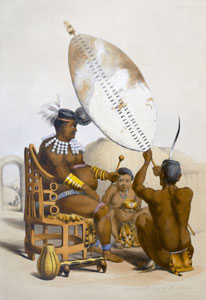
Ironically, the actions of Zulu General Ndlela kaSompisi, who encouraged Dingane to kill Retief’s men, and who won the Battle of Italeni but lost the Battle of Blood River, also ensured peace between a Zulu prince and the Trekkers, and Ndlela’s own death. In the unrest that followed the Zulu defeat, Dingane ordered Ndlela to kill the only surviving crown prince Mpande (two other half-brother princes had been assassinated along with Shaka in 1828). Ndlela refused, as he was trying to ensure a successor of royal lineage to the Zulu throne. In October 1839, Mpanda fled with 17,000 of Dingane’s followers to the Trekker Republic of Natalia where he sought refuge with Pretorius. Dingane ordered Ndlela’s excecution.
The English evacuated Port Natal in December 1839, leaving Pretorius free to govern the new Trekker Republic of Natalia without interference until May 1842, when British troops would reoccupy Port Natal. Pretorius and Mpanda’s alliance led to a final victory over Dingane’s forces at the Battle of the Macongco in January 1840. Some 36,000 head of cattle were recovered and taken back to Natalia, although the ownership/theft/recovery of cattle would bring much trouble in the future. Dingane fled to the Swazi border where he was assassinated by a group of Nyawo and Swazi men. Mpande was proclaimed king of the Zulus on 10 February 1840 on the Black Mfolozi river, and recognized as such by Pretorius in Pietermaritzburg on February 14, leading to a period of tentative friendship between Zulu and Trekker. Mpande would reign until 1872, the longest rule of any king of the Zulus. R efugee Zulus streamed back into Natalia, many settling on the new Trekker farms. In October 1840 Pretorius and Potgieter agreed to a loose federation between Natalia and the highveld republics.
In the Trans-Vaal, new emigrant republics sprung up with names like Winburg-Potchefstroom Republic, Andries Orighstad Republic and the Lydenburg Republic (finally divided into the two Boer Republics which was recognized by Britain as the Zuid Afrikaansche Republic in 1852—also known as the Republic of Transvaal—and the Oranje Vrij Staat in 1854.) Some of the farms that Hendrik Potgieter granted to emigrants in these early republics were on land that Potgieter had obtained in a trade deal with the BaRolong chief Moroka back in 1837 (after the emigrants survived the Matabele attack on Vegkop), in exchange for a considerable amount of cattle. Other farms were on land that Potgieter considered conquered territory after Mzilikazi and his Matabele followers fled north of the Limpopo river as a result of their defeat at Mosega and Kapain.
As they trekked further north, Lourens and Daniel Erasmus’ names were written in the “Potgieter-I Register” for land grants: in 1838 the farms De Rooderand and De Buffelsleegte; in 1840 De Sterkfontyn and De Heksterivier, De Tweedepoort, Nooitgedacht; De Yzerfontyn near the Crocodile River, which was in bushveld territory where sheep did not do well. The Erasmuses started farming exclusively with cattle. Tweedepoort may be the place where Lourens’ first wife, our 3rd great-grandmother Helena Geertruij Bekker (1784–1840), whom Lourens married in Cape Town in 1800, lies buried. She lived her whole married life in an ox wagon, giving birth to seven children while the family trekked from one place to another. Helena Bekker’s forebears have some amazing stories, but the Bekker (Cape) stamvader would be best cut out of the annals of ancestry.
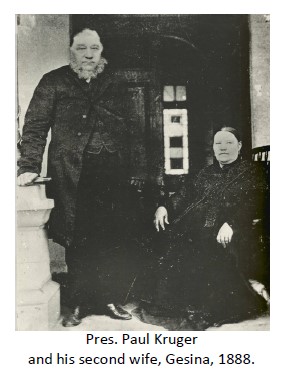
It is interesting what one can dig out in some of these Voortrekker histories… (if you care for such details!) President Paul Kruger (1825–1904), who was a boy of eleven, twelve years old when his parents participated in the Groot Trek, first married a young girl by the name of Anna Maria Etresia du Plessis in 1842. This Maria du Plessis grew up with our Erasmus families.
The seventeen-year old Paul and his sixteen-year old bride Maria settled on the farm Waterkloof, near Rustenburg—which is where some twenty-odd years later, our oupagrootjie Jan Heystek would become acquainted with the Kruger family. (He bought Boekenhoutfontein much later.) Maria and her third baby died of malaria in 1846. Paul married Maria’s cousin, Gezina du Plessis, a year later. Talking about famous Trekker-family marriages: another one was that of 2nd-great-grandfather Daniel Erasmus’ sister, the widow Catharina Elizabeth Erasmus-Jacobs, who became Hendrik Potgieter’s third and last wife in 1843.
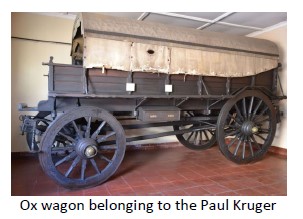
The Malans also stayed in Natalia for a few years. Anna Maria Klopper-Malan and her children must have stayed with the Malan clan, maybe settling in at the Malanspruit near Estcourt? The Malans moved to the Transvaal somewhere between 1846 and 1851. The farm, Malanskraal, southeast of Johannesburg in Mpumalanga was renamed after the farm back on the Oosgrens, as was typical for many Dutch emigrant families to do in their new republics. In our Wentzel lines the Snymans and van Rooyens also made their way up to the Brits/Potchefstroom/ Rustenburg area, but I have only their children’s birthdates as from 1854 onwards in those towns.
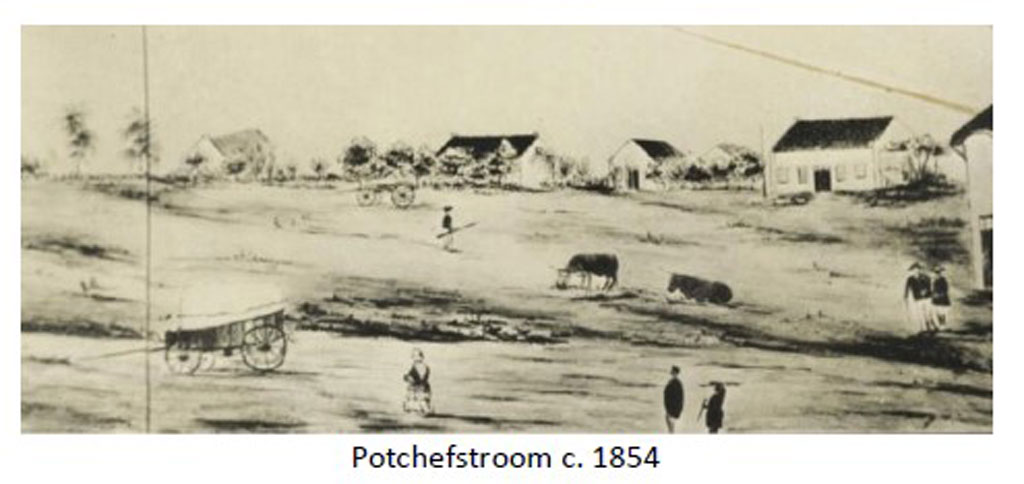
By 1841 Pietermaritzburg had grown as the administrative and commercial center of the Trekkers. They also fulfilled their vow to God, spoken by Sarel Cilliers and taken by Andries Pretorius, our Malan and Erasmus great-grandfathers and the rest of the Wen Kommando at Danskraal just before the Battle of Blood River in 1838. The small “Geloftekerk” (Church of the Vow) was erected in Pietermaritzburg. After our oupagrootjie Jan Heystek and his father and siblings arrived in Durban twenty-one years later, they spent almost a month in Pietermaritzburg en route to the Transvaal. The family was given lodging in this same Geloftekerk. Jan could not have known that he would one day marry the daughter of Helena Malan who, with her family, attended services at this little church in those first few years of the Republic of Natalia, or that his future in-laws had so much history here in Natal. Nor would Jan have known that another three years later he would travel back to Pietermaritzburg with Tjaard Kruger to sell his first small crop of tobacco.
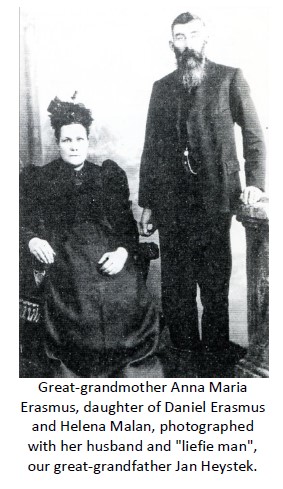
The Republic of Natalia formally ceased to exist in December 1845, with Andries Pretorius leading the last few burghers to the Transvaal highveld a couple of years later. Stephanus Erasmus followed Pretorius, and finally found himself living next to his brother, our 3rd-great-grandfather Lourens Erasmus, for some years in the Orighstad area (today’s Lydenburg). Stephanus lies buried on the farm of his daughter and son-in-law, Carolus Trichardt, son of the very first Voortrekker Louis Trichardt. Cape Colonists who trekked to the new republics after 1846 would be called Agtertrekkers, while those who made it to Natal and the Trans-Vaal before 1846 became known as the Voortrekkers.
Previously published on: https://www.facebook.com/groups/Lampens/
Resources:
https://www.wikitree.com/photo.php/2/24/Erasmus-843.pdf – Lewensverhaal van
Pionierboer en Voortrekker Lourens Abraham Erasmus,
N.A. Coetzee en E.M. Erasmus.
Lampen Familie Post #26, August 25, 2017:
Great-grands Jan & Jan Heijstek: New Life in South Africa I
Google books: Historical Dictionary of the Zulu Wars, John Laband
https://en.wikipedia.org/wiki/Dingane_kaSenzangakhona
http://www.africaelephants.com/dingane.htm – Mpanda betrayal of Dingane story
http://uzspace.uzulu.ac.za/handle/10530/839 – Zulu-Republic of Natalia-British
relationships.
Google books: Selections from the Smuts Papers: Volume VII, August 1945-October 1950,
Jean van der Poel
https://en.wikipedia.org/wiki/Potchefstroom;
http://www.theheritageportal.co.za/article/founding-potchefstroom
Voortrekker Stamouers 1835–1845, Jan C. Visagie (Digest of Voortrekker family names,
dates of departure and trek groups.)
http://www.sahistory.org.za/people/stephanus-johannes-paulus-kruger
http://www.crwflags.com/fotw/flags/za-boer.html – 19th Century Boer Republics
http://www.genza.org.za/index.php/en/branch-activities/324-voortrekker-farms-and-other-rak-registers Potgieter registers and more.
All images used are in public domain.
***